AMD Kaveri APU Launch Details: Desktop, January 14th
by Ryan Smith on November 11, 2013 9:33 PM EST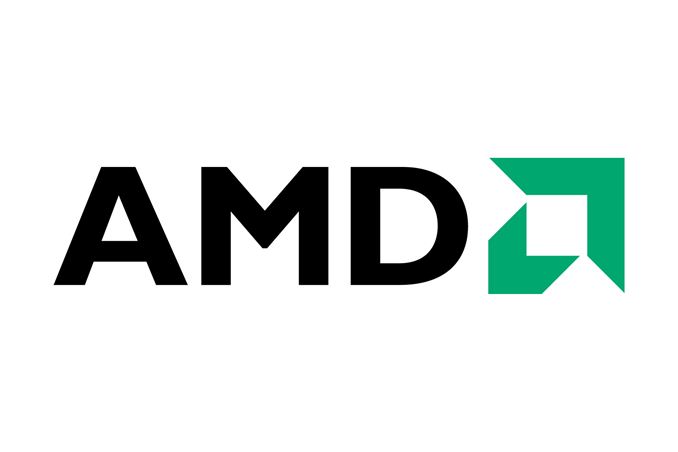
Kicking off today is AMD’s annual developer conference, which now goes by the name APU13. There will be several APU/CPU related announcements coming out of the show this week, but we’ll start with what’s likely to be the most interesting for our regular readers: the launch date for AMD’s Kaveri APU.
First and foremost, AMD has confirmed that Kaveri will be shipping in Q4’13, with a launch/availability date of January 14th, 2014. For those of you keeping track of your calendars, this is the week after CES 2014, with AMD promising further details on the Kaveri launch for CES.
Second of all, we have confirmation on what the highest shipping APU configuration will be. Kaveri will have up to 4 CPU core (2 modules), which will be based on AMD’s latest revision of their desktop CPU architecture, Steamroller. Meanwhile the GPU will be composed of 8 GCN 1.1 CUs, which would put the SP count at 512 SPs (this would be equivalent to today's desktop Radeon HD 7750). Furthermore AMD is throwing around a floating point performance number – 856 GFLOPS – which thanks to some details found in AMD's footnotes by PCWorld gives us specific clockspeeds and even a product name. A10-7850K CPU clockspeed 3.7GHz, GPU clockspeed 720MHz.
Third, in a departure from how AMD launched Trinity and Richland, Kaveri will be coming to the desktop first. The January 14th date is for the availability of desktop socket FM2+ Kaveri APUs, with server and mobile APUs to follow (these are presumably some of the CES details to come). Pricing and specific SKUs will of course be announced at a later time, and there wasn’t any clarification on whether this was just for OEM hardware, or if we’ll be seeing retail CPUs too.
Finally, AMD has confirmed on the GPU side that Kaveri will be shooting for feature parity with AMD’s latest discrete GPUs, by supporting many of the same features. Specifically, TrueAudio will be making an appearance on Kaveri, bringing AMD’s dedicated audio processing block to their APUs as well as their GPUs. On the discrete GPUs this is a move that was mostly about functionality, but on Kaveri it should take on a second role due to the fact that it’s exactly the kind of CPU-constrained environment for which having dedicated hardware will be a boon. Furthermore, AMD has also confirmed that their new low-level API, Mantle, will also be supported on Kaveri – it is after all a GCN based GPU.
For AMD Kaveri is going to be a big deal; likely the biggest CPU/APU launch for the company in quite some time. Since the acquisition of ATI all the way back in 2006 this is what the company has been building up to: producing a processor with a highly integrated CPU/GPU that allows both of them to be leveraged nearly-transparently by software. Kaveri is the launch vehicle for HSA both as a specific standard and as a general concept for a PC CPU/APU, so it’s something that everyone inside and outside of AMD will be watching closely.


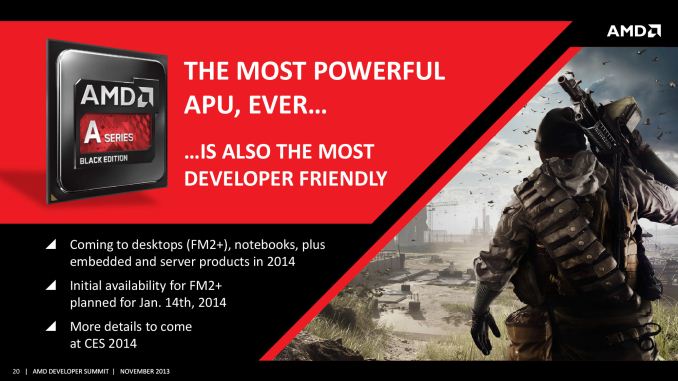
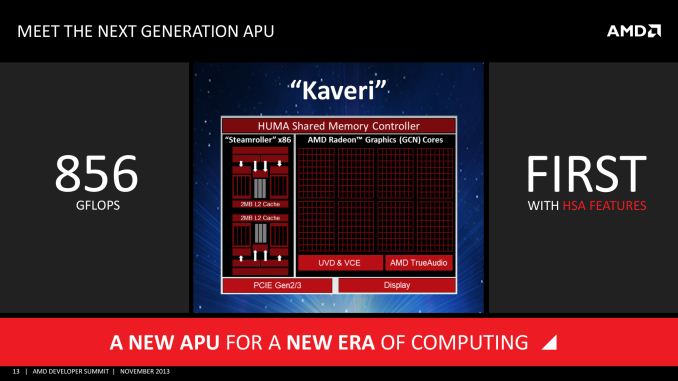
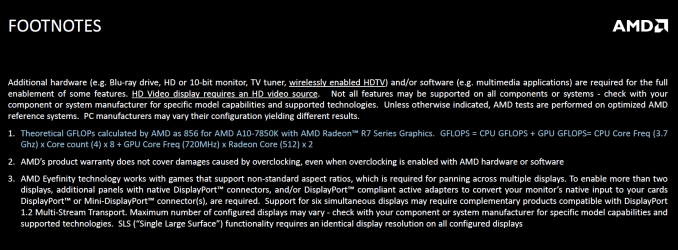

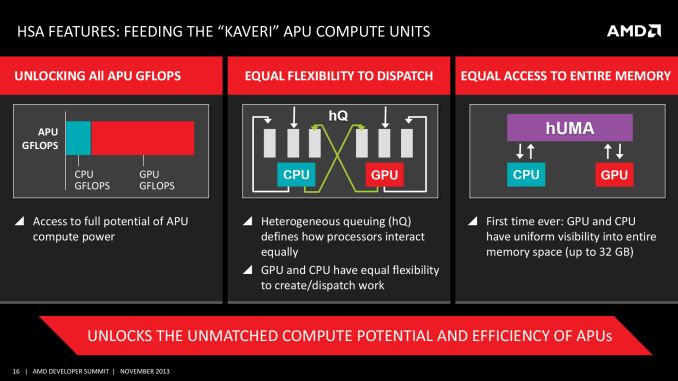








97 Comments
View All Comments
SunLord - Tuesday, November 12, 2013 - link
You should be able to get 30+fps out of this in BF4 on the lowest gfx settings one would think.Nagorak - Tuesday, November 12, 2013 - link
Wow, spend an extra $100 bucks and get him something that can run faster than 30fps. 30 fps sucks for gaming. It's playable but that's it. Make your kid earn some money around the house doing chores or whatever, but don't consign him to 30 fps hell!silverblue - Tuesday, November 12, 2013 - link
A constant 30fps isn't bad. I'm interested in how Mantle affects this once it's available, however in general you'll be dropping settings down a bit to ensure a decent framerate floor. Having said that, in the past there's never really been any question about running games in medium quality in 1080p as it's been an exercise in pointlessness, so we're getting closer to having integrated graphics that can truly take over from all but the mid-high and higher range cards.Da W - Tuesday, November 12, 2013 - link
That Ain't the point dummy! The point is bing able to build a rif with a siple 150$ APU and below 99$ MB and bé able to plat gammes. Sure you're gonna have better GPS with a GTX 780 Ti.rituraj - Tuesday, November 12, 2013 - link
There's a ghost sitting on your finger...looncraz - Tuesday, November 12, 2013 - link
You would have to spend far more than another $100 to get better performance using discrete solutions. You still need a decent CPU, so you are looking at $85 on the lowest side there, then you need a video card able to push significantly more than the APU. You're looking at $100 just for performance parity, $135 gets you the R7 260X, which is really the cheapest feature-parity performance-superior product available.Then you need a better power supply as well... you can't buy one of the cheap $35/$45 quality 300W power supplies... you'll need a decent 450-500W power supply for any half-decent discrete solution.
You can do all that, or you can just buy the top-end $130 or so APU and a good aftermarket cooler on a half-decent motherboard with some good RAM and a cheap HDD...
Malih - Monday, November 11, 2013 - link
Looks like it's going to be in my next HTPC/Light gaming boxPenti - Monday, November 11, 2013 - link
Graphics is essentially where I thought, they still cheap a bit and is essentially at Intel levels in terms of GFLOPS (my guess would have been 700-800 GFLOPS, and yes 512 SP with HSA-features). They have to be careful with notebook parts, they cannot keep cutting back there. On the notebook side it has to compete against Broadwell and new Haswell skus after all. Seems to be just a few weeks short of a 2013 launch and manufacturing seems to be on track, to bad they didn't push for limited availability for 2013. Gives them a lot of bad PR.Nice to see some more details coming out. Mantle is a bit overplayed though, and more details won't come out till 13 th nov so I don't get why a lot people rage about it. It's low level, access into the inner workings of the drivers basically but it isn't a replacement for the higher more abstracted api's, it's not writing gpu microcode either and if you wanted to keep up with features without running the latest Windows version then there was always OpenGL and still is, features like Partially Resident Textures was developed and was available on OGL for years before it became part of DX. It's great if it is a complement you can use together with OGL or D3D, but that is not what people expect here really. Plus OpenCL is the main compute API here any way. C++ targeting HSAIL won't sideline it the models is good for different tasks.
meacupla - Monday, November 11, 2013 - link
HD5x00 graphics equipped Haswell eats up more power. So much so, that AMD APUs don't look too bad on the mobile and ultra portable market.15W, i5-4300U, 2.9Ghz turbo, HD4400
28W, i5-4258U, 2.9Ghz turbo, HD5100 <-13W increase in TDP with improved graphics
25W, A10-5745M, 2.9Ghz turbo, HD8610G
35W, A10-5757M, 3.5Ghz turbo, HD8650G <- probably closer to the performance Haswell U offers.
Penti - Tuesday, November 12, 2013 - link
The problem is that they usually cut stream processors and clock speed on the mobile chips. A GT3-chip at 28W is still 700 GFLOPS. 8650G is 400 GFLOPS and HD4400 is roughly 350 GFLOPS. Drivers don't make up for it on that scale. Plus the 5757M isn't really 35W. Plus basically get half the battery life of a comparable Haswell machine.